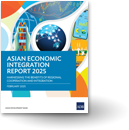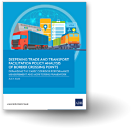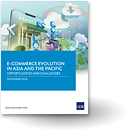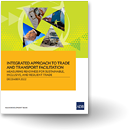Unlocking Climate Investments: Lessons for Asia from the Inflation Reduction Act
Ambitious climate policies, clear decarbonization commitments, and measures like carbon pricing, subsidies and blended finance can attract foreign private capital for green investments, as shown by the 2022 US Inflation Reduction Act’s impact on climate finance.
Asia and the Pacific faces significant climate-related risks, including rising temperatures, extreme weather events, and environmental degradation, which threaten the region’s economic stability, infrastructure, and livelihoods.
Meeting climate financing needs is essential to fund the transition to clean energy, enhance climate resilience, and mitigate these risks to ensure sustainable development and protect vulnerable populations.
Investment funds can make an important contribution, raising private climate finance in times of reduced fiscal headroom for public sector support.
The region needs $1.1 trillion annually for mitigation and adaptation according to the International Monetary Fund. The investment funds’ allocations to Asia and the Pacific are historically prominent, with flows cumulatively reaching about 30% of GDP for the period 2015–2022.
The 2022 US Inflation Reduction Act, a sweeping legislative measure that touched on many aspects of the US economy, included the most forceful climate action in US history. It brings a combination of tax credits, grants, and loans worth at least $370 billion to encourage private sector investments in clean energy aimed at reducing US emissions by 40% by 2030, relative to 2005 levels.
Our research found that investment funds with a sustainability mandate received more inflows from investors after the announcement of the Inflation Reduction Act in September 2021. In turn, these sustainable funds increased their cross-border investments to Asia and the Pacific.
In the three months after the Inflation Reduction Act announcement, the Act had triggered additional investments of $1.4 billion into sustainable funds, equivalent to a 100% increase. In turn, sustainable funds translated the additional capital from investors directly into higher cross-border investments to the region, reaching 3% of GDP.
Why does the Inflation Reduction Act induce a shift in investor portfolios in favor of sustainable funds?
Following decades of US legislative initiatives to address climate change, the Inflation Reduction Act was widely perceived a credible US commitment to accelerate the transition to net zero.
This instantly increased investors’ expectations of future income derived from assets tied to sustainable activities, compared to conventional, carbon-intensive activities. Thus, sustainable funds became more attractive investments.
Why did the IRA affect the behavior of investors around the world?
The Inflation Reduction Act announcement shaped the investment choices of non-US investors, as a US commitment to climate action improved the chances of progress on the global climate agenda, and hence made the launch of similar green industrial policies worldwide more likely.
As a result, non-US headquartered sustainable investment funds saw most of the inflows upon announcement of the Inflation Reduction Act, in turn investing into Asia and the Pacific.
Policy makers can rely on ambitious decarbonization policies to attract more foreign investments into climate action. Such policies attract inflows of sustainable capital, as foreign investors read climate change-related policies as a commitment to efficiently use foreign capital for climate action, implying higher returns on investment.
Decarbonization commitments, as enshrined in Nationally Determined Contributions and related laws, further reduce policy uncertainty, thus creating a strong incentive for foreign investors. Economies with highly ambitious policies received more inflows from sustainable investment funds after the Inflation Reduction Act, worth an additional 3% of GDP.
Besides ambitious climate policies, policy makers can attract foreign capital for climate action by creating favorable investment conditions. These comprise stable macroeconomic conditions as well as strong legal and regulatory frameworks, including adequate enforcement capacity, efficient public budget management systems, and clearly articulated climate investment priorities. A pipeline of bankable, large-scale projects also helps attract foreign investors.
Public sector support can be decisive to improve foreign investors’ risk return balance. Subsidies and preferential tax treatment for climate investments – compliant with fiscal sustainability principles – can be crucial to unlock foreign climate investments.
Blended finance instruments such as first-loss guarantees and subordinated loans can prove crucial to de-risk projects. Establishing binding carbon pricing can also help align investment fund allocations with climate financing needs.
The climate financing provided by sustainable investment funds after the Inflation Reduction Act accounts only for a small share of the potentially available climate finance from investment funds. Sustainable funds’ investments after the Inflation Reduction Act are not only driven by higher inflows into the funds, but also the fund managers’ active portfolio reallocation in favor of countries with ambitious climate policies.
Importantly, even conventional funds exhibit this portfolio shift. As conventional funds represent 97% of the fund industry’s assets under management, more stringent climate policies can yield significantly more private financing for climate action. That is, tilting conventional funds’ investments towards sustainability objectives may yield larger gains in green investments than promoting the growth of sustainable funds.
Uncertainties about the implementation of the Inflation Reduction Act notwithstanding, investment funds’ reaction to the Inflation Reduction Act meaningfully increased the supply of climate finance to Asia. To attract and retain foreign private climate capital, ambitious decarbonization policies are key to signal regional policy makers’ strong commitment and capacity to tackle climate change.
This blog post is based on research for the Asia-Pacific Climate Report. Daniel Marcel te Kaat, an associate professor of finance at the University of Groningen, and Yuanjie Tian, a PhD candidate at Southwestern University of Finance and Economics, contributed to the report and this blog post. Original article was published at the Asian Development Blog and duplicated here with permission from the author. *




